1996 CHEVROLET S10 inflation pressure
[x] Cancel search: inflation pressurePage 173 of 375
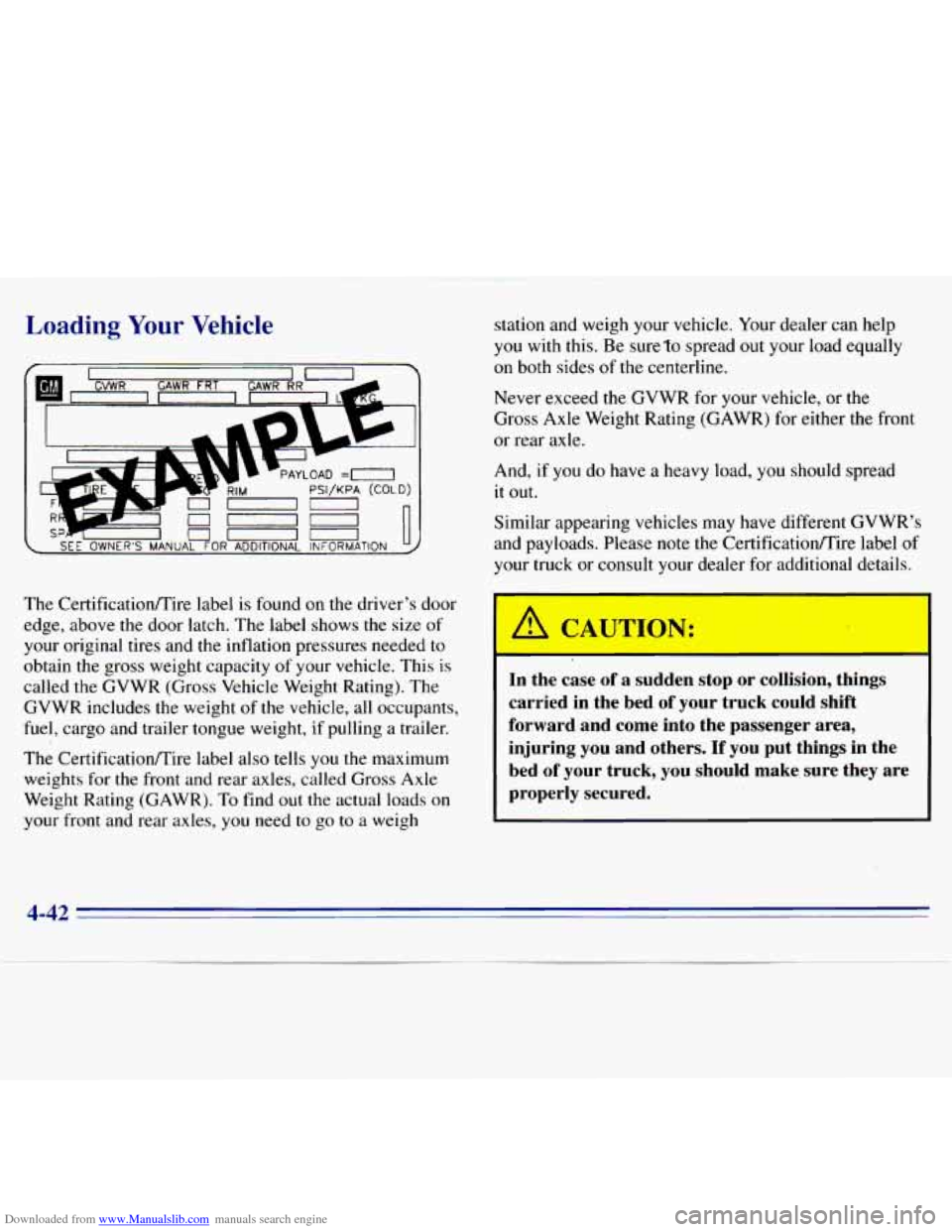
Downloaded from www.Manualslib.com manuals search engine Loading Your Vehicle
< SEE OWNER'S MANUAL FOR ADDITIONAL INFORMATION uu-
The CertificatiodTire label is found on the driver's door
edge, above
the door latch. The label shows the size of
your original tires and the inflation pressures needed to
obtain the gross weight capacity of your vehicle. This is
called the GVWR (Gross Vehicle Weight Rating). The
GVWR includes the weight
of the vehicle, all occupants,
fuel, cargo and trailer tongue weight, if pulling a trailer.
The Certificationmire label also
tells you the maximum
weights for the front and rear axles, called Gross Axle
Weight Rating (GAWR). To find out the actual loads
on
your front and rear axles, you need to go to a weigh station and weigh your vehicle.
Your dealer can help
you with this. Be sure'to spread out your load equally
on both sides of the centerline.
Never exceed the GVWR for your vehicle, or
the
Gross Axle Weight Rating (GAWR) for either the front
or rear axle.
And, if you do have a heavy load, you should spread
it out.
Similar appearing vehicles may have different GVWR's
and payloads. Please note the Certificationire label
of
your truck or consult your dealer for additional details.
I
. A CAUTION:
I
In the case of a sudden stop or collision, things
carried in the bed of your truck could shift
forward and come into the passenger area,
injuring you and others.
If you put things in the
bed of your truck, you should make, sure they are
properly secured.
4-42
Page 222 of 375
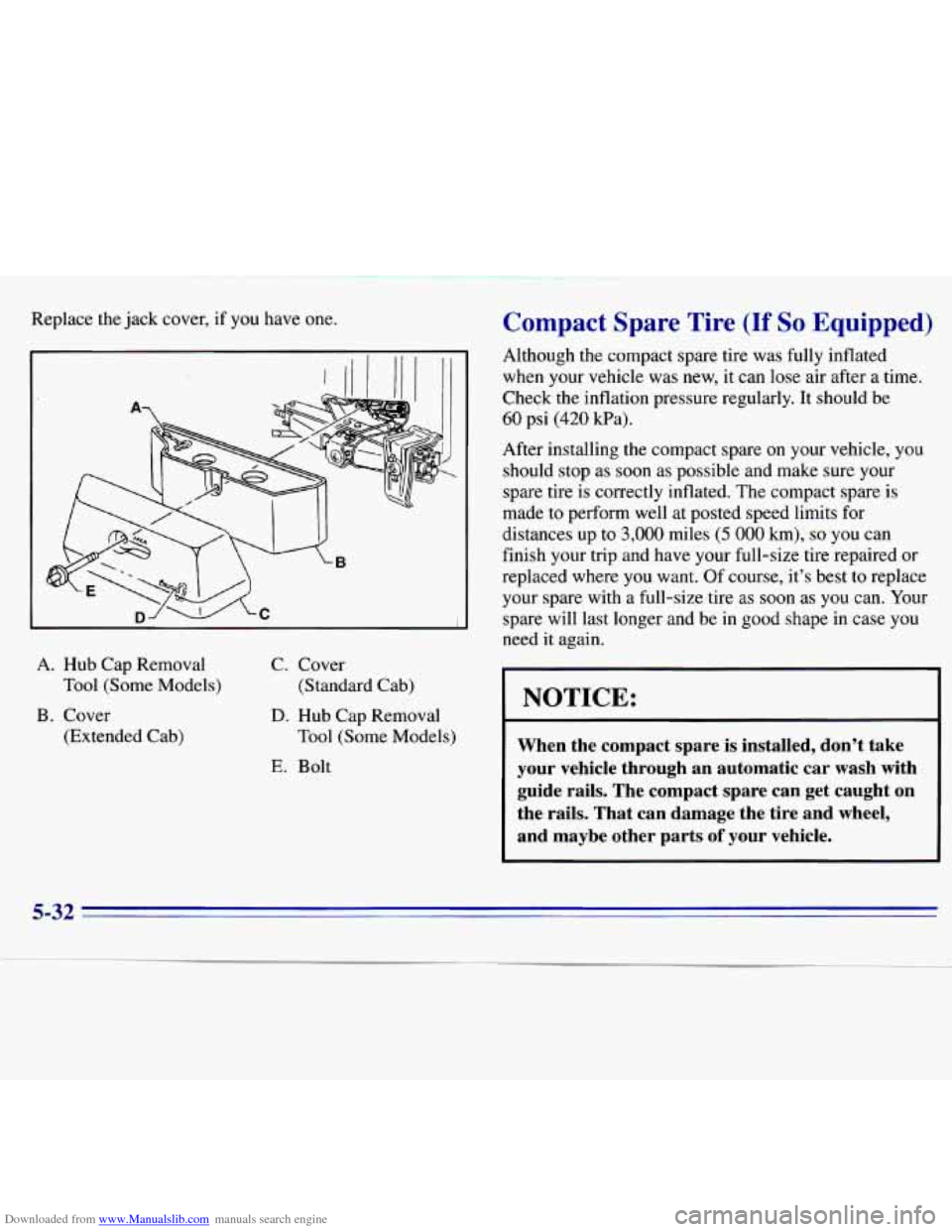
Downloaded from www.Manualslib.com manuals search engine Replace the jack cover, if you have one.
A. Hub Cap Removal
Tool (Some Models)
B. Cover
(Extended Cab) C.
Cover
(Standard Cab) D. Hub Cap Removal
E. Bolt Tool
(Some Models)
Compact Spare Tire (If So Equipped)
Although the compact spare tire was fully inflated
when your vehicle was new,
it can lose air after a time.
Check the inflation pressure regularly. It should be
60 psi (420 Pa).
After installing the compact spare on your vehicle, you
should stop as soon as possible and make sure your
spare tire is correctly inflated. The compact spare is
made to perform well at posted speed limits for
distances up to
3,000 miles (5 000 km), so you can
finish your trip and have your full-size tire repaired or
replaced where you want.
Of course, it’s best to replace
your spare with
a full-size tire as soon as you can. Your
spare will last longer and be
in good shape in case you
need it again.
NOTICE:
When the compact spare is installed, don’t take
your vehicle through an automatic car wash
with
guide rails. The compact spare can get caught on
the rails. That can damage the tire and wheel,
and maybe other parts
of your vehicle.
5-32
Page 271 of 375
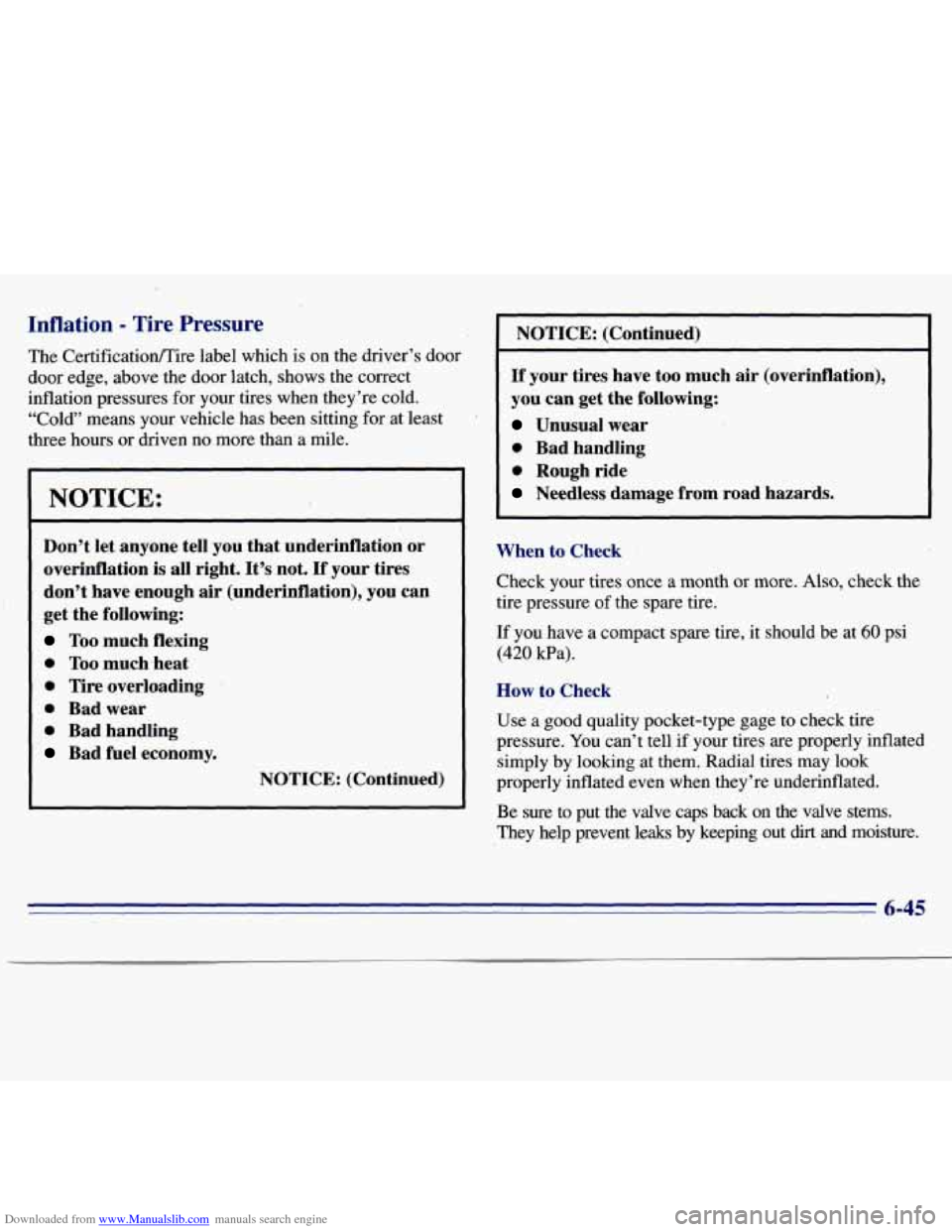
Downloaded from www.Manualslib.com manuals search engine Inflation - Tire Pressure
The Certificatioflire label which is on the driver’s door
door edge, above the door latch, shows the correct
inflation pressures for your tires when they’re cold.
“Cold” means your vehicle has been sitting for at least
three hours or driven no more thana mile.
NOTICE:
Don’t let anyone tell you that underinflation or
overinflation
is all right. It’s not. If your tires
don’t have enough
air (underinflation), you can
get the following:
Too much flexing
0 Too much,heat
0 Tire overloading :
0 Bad wear
0 Bad handling
Bad fuel economy.
NOTICE: (Continued) NOTICE: (Continued)
If your tires have too much air (overinflation),
you can get the following:
Unusual wear
0 Bad handling
e Rough ride
Needless damage from road hazards.
When to Check Check your tires once a month or
more. Also, check the
tire pressure of the spare tire.
If you have a compact spare tire, it should be at 60 psi
(420 Wa).
How to Check
Use a good quality pocket-type gage to check tire
pressure.
You can’t tell if your tires are properly inflated
simply by looking at them. Radial tires may look
properly inflated even when they’re underinflated.
Be sure to put the valve caps back
on the valve stems.
They help prevent leaks by keeping out
dirt and moisture.
. 6-45
Page 273 of 375
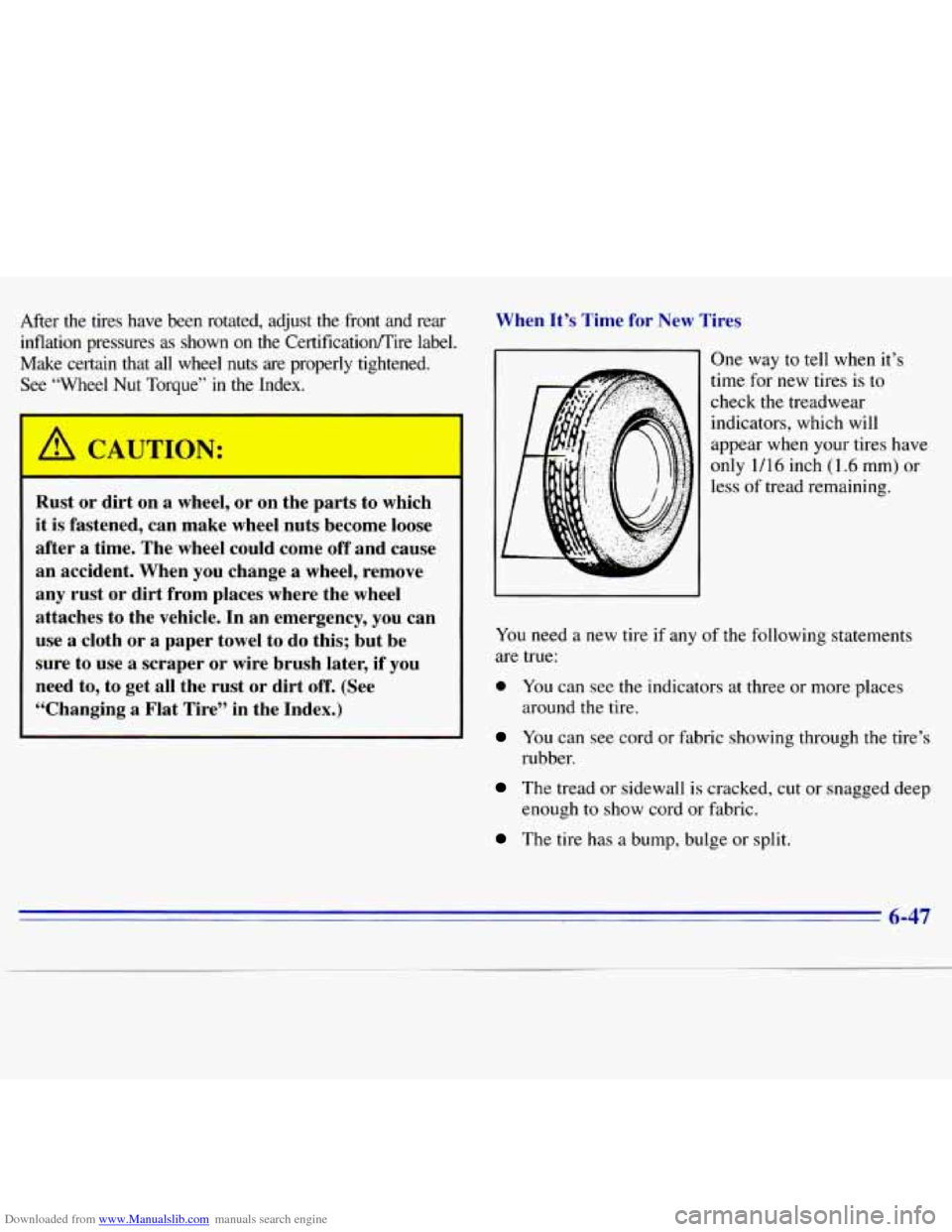
Downloaded from www.Manualslib.com manuals search engine After the tires have been rotated, adjust the front and rear
inflation pressures as shown on the Certificatioflire label.
Make certain that all wheel nuts are properly tightened. See ‘”Wheel Nut Torque” in the Index.
Rust or dirt on a wheel, or on the parts to which
it is fastened, can make wheel nuts become loose
after
a time. The wheel could come off and cause
an accident. When you change
a wheel, remove
any rust or dirt from places where the wheel
attaches to the vehicle. In an emergency, you can
use a cloth or
a paper towel to do this; but be
sure
to use a scraper or wire brush later, if you
need to, to get all the rust or dirt off. (See
“Changing a Flat Tire” in the Index.) When
It’s Time for New Tires
11 One way to tell when it’s
time for new tires is to
check the treadwear
indicators, which will
appear when your tires have
only
1/16 inch (1.6 mm) or
less of tread remaining.
You need a new tire if any of the following statements
are true:
0 You can see the indicators at three or more places
You can see cord or fabric showing through the tire’s
The tread or sidewall is cracked, cut or snagged deep
around
the tire.
rubber.
enough
to show cord or fabric.
The tire has a bump, bulge or dit.
6-47
Page 343 of 375
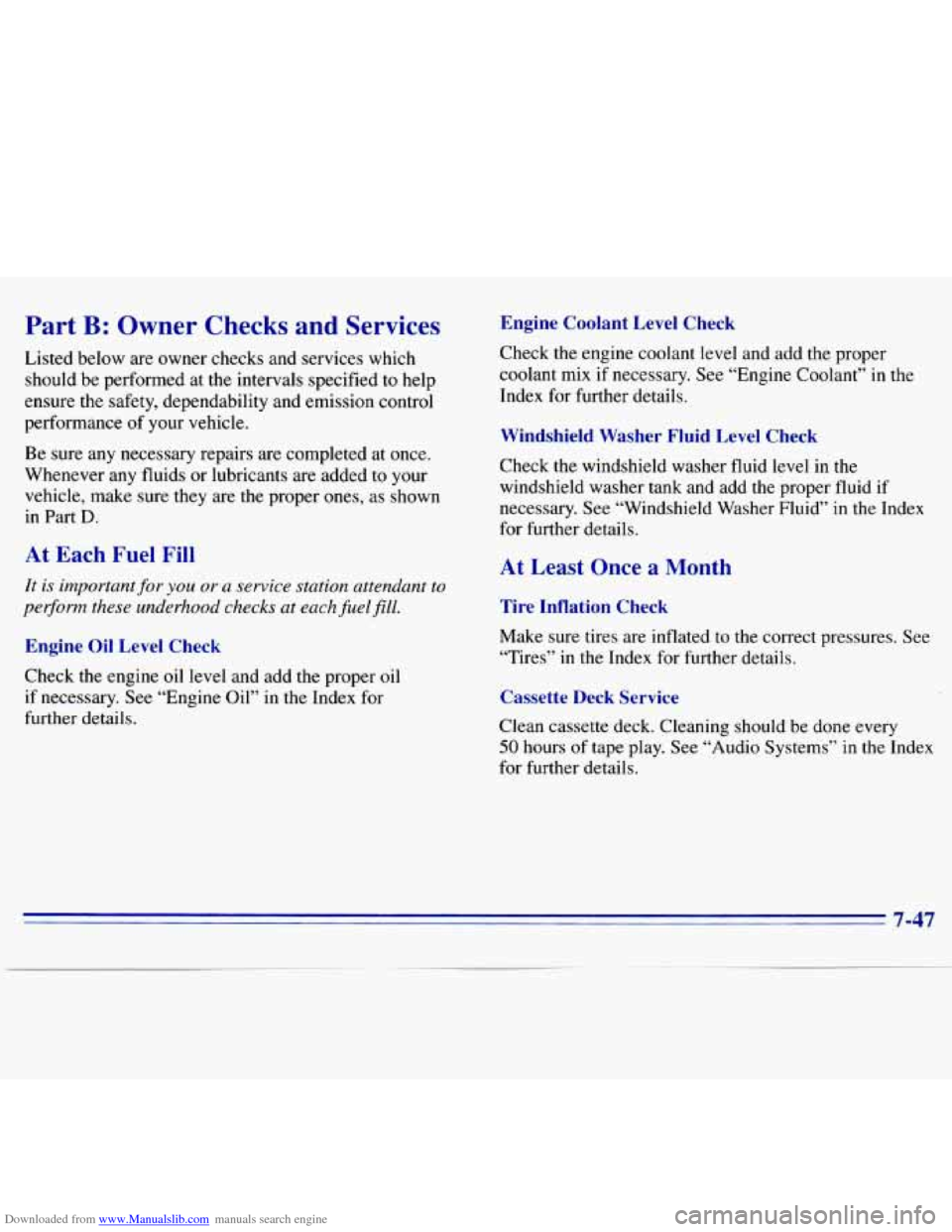
Downloaded from www.Manualslib.com manuals search engine Part B: Owner Checks and Services
Listed below are owner checks and services which
should be performed
at the intervals specified to help
ensure the safety, dependability and emission control
performance
of your vehicle.
Be sure
any necessary repairs are completed at once.
Whenever any fluids or lubricants are added
to your
vehicle, make sure they are the proper ones, as shown
in Part
D.
At Each Fuel Fill
It is important for you or a service station attendant to
pegorm these underhood checks at each fuel
fill.
Engine Oil Level Check
Check the engine oil level and add the proper oil
if necessary. See “Engine Oil” in the Index for
further details.
Engine Coolant Level Check
Check the engine coolant level and add the proper
coolant mix if necessary. See “Engine Coolant” in
the
Index for further details.
Windshield Washer Fluid Level Check
Check the windshield washer fluid level in the
windshield washer tank and add the proper fluid if
necessary. See “Windshield Washer Fluid” in the Index
for further details.
At Least -Once a Month
Tire Inflation Check
Make sure tires are inflated to the correct pressures. See
“Tires”
in the Index for further details.
Cassette Deck Service
Clean cassette deck. Cleaning should be done every
50 hours of tape play. See “Audio Systems” in the Index
for further details.
7-47
Page 373 of 375
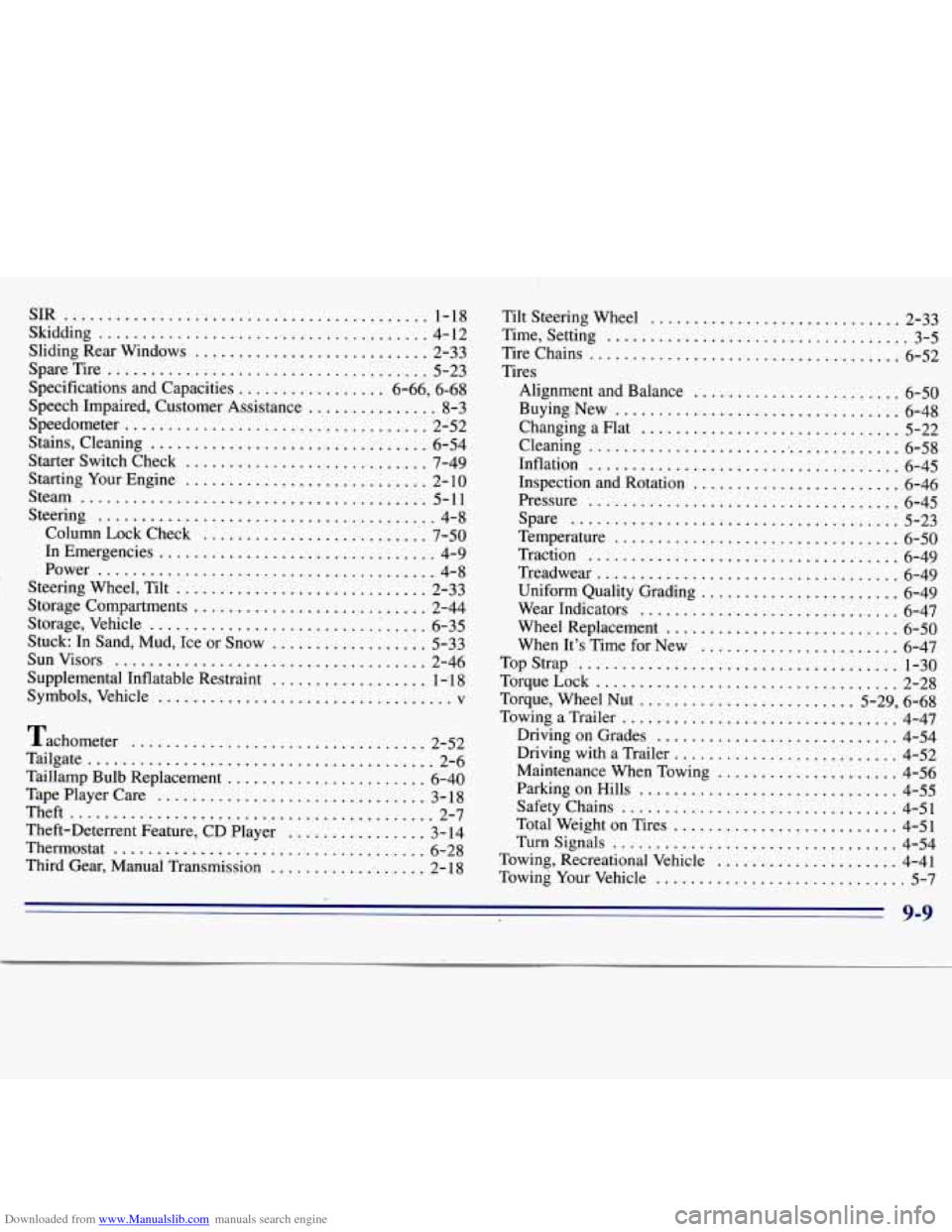
Downloaded from www.Manualslib.com manuals search engine SIR .......................................... 1-18
Skidding
...................................... 4-12
Sliding Rear Windows
........................... 2-33
SpareTire
..................................... 5-23
Specifications and Capacities
................. 6-66, 6-68
Speech Impaired, Customer Assistance
............... 8-3
Speedometer
................................... 2-52
Stains, Cleaning
................................ 6-54
Starting Your Engine
............................ 2- 10
Steering
......................................... 4-8
Column Lock Check
.......................... 7-50
In Emergencies ................................ 4-9
Power
........................................ 4-8
Steering Wheel, Tilt
............................. 2-33
Storage Compartments
........................... 2-44
Storage, Vehicle
................................ 6-35
Stuck:
In Sand, Mud, Ice or Snow .................. 5-33
Sunvisors
.................................... 2-46
Supplemental Inflatable Restraint
................... 1 -I8
Symbols, Vehicle
................................... v
Tachometer .................................. 2-52
Tailgate
........................................ 2-6
Taillamp Bulb Replacement
....................... 6-40
TapePlayerCare
............................... 3-18
Theft
........................................... 2-7
Theft-Deterrent Feature,
CD Player ................. 3- 14
Thermostat
.................................... 6-28
Third Gear, Manual Transmission
................... 2- 18
Starter Switch Check
....................... ., .... 7-49
Steam
........................................ 5-11 Tilt
Steering Wheel
............................. 2-33
Time. Setting
................................... 3-5
Tires Tire Chains
.................................... 6-52 .
Alignment and Balance ........................ 6-50
Buying New
................................. 6-48
Changing a Flat
.............................. 5-22
Cleaning
..................................... 6-58
Inflation
.................................... 6-45
Inspection and Rotation
........................ 6-46
Pressure
.................................... 6-45
Spare
...................................... 5-23
Temperature
.......................... ...... 6-50
Traction
.................................... 6-49
Treadwear
................................... 6-49
Uniform Quality Grading
....................... 6-49
Wear Indicators
.............................. 6-47
Wheel Replacement
.................... ...... 6-50
When It’s Time for New
....................... 6-47
TorqueLock
................................... 2-28
Torque, Wheel Nut
......................... 5-29, 6-68
TowingaTrailer ................................. 4-47
Driving on Grades
............................ 4-54
Driving with a Trailer
.......................... 4-52 1
Maintenance When Towing ..................... 4-56
Parking on Hills
.............................. 4-55 ~ 1
Safety Chains ................................ 4-51
Total Weight on Tires
.......................... 4-51
Turn Signals
.................................. 4-54
Towing, Recreational Vehicle
..................... 4-41
Towing
Your Vehicle ............................. 5-7
TopStrap
..................................... 1-30
9-9
J